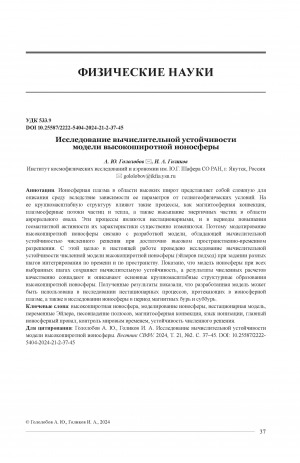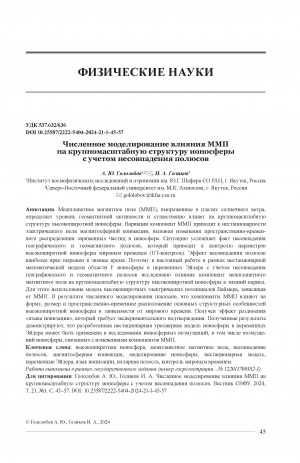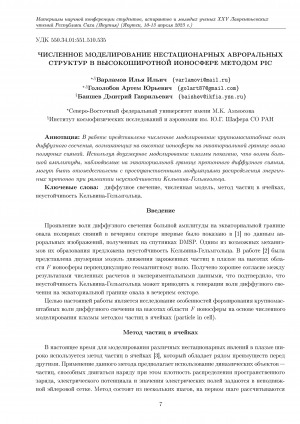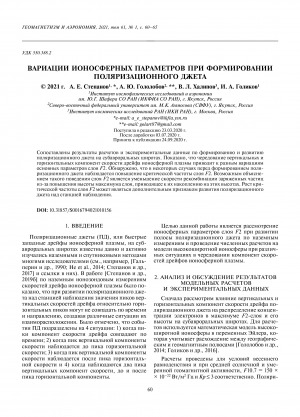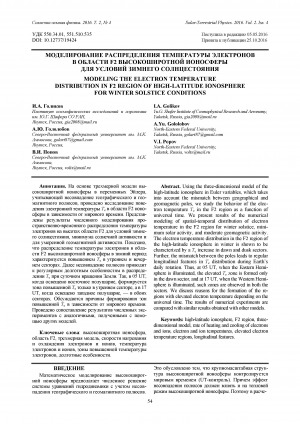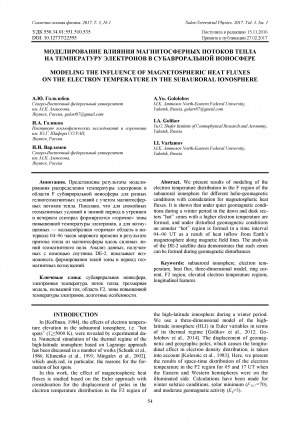Место работы автора, адрес/электронная почта: Северо-Восточный федеральный университет им. М. К. Аммосова, Физико-технический институт ; 677013, г. Якутск, ул. Кулаковского, 48 ; e-mail: aiu.gololobov@s-vfu.ru, golart87@gmail.com ; https://www.s-vfu.ru/
Ученая степень, ученое звание: канд. физ.-мат. наук
Область научных интересов: Физика верхней атмосферы, математическое моделирование ионосферы, численное решение дифференциальных уравнений
ID Автора: SPIN-код: 2298-7721, РИНЦ AuthorID: 747807
Количество страниц: 9 с.
The high latitude ionospheric plasma is a difficult medium to describe due to the dependence of its parameters on heliogeophysical conditions. Its large-scale structure is influenced by processes such as magnetospheric convection, plasmaspheric flows of particles and heat, as well as the precipitation of energetic particles in the region of the auroral oval. These processes are non-stationary and their characteristics change significantly during periods of enhanced geomagnetic activity. Therefore, the modelling of the high-latitude ionosphere is associated with the development of a model that has a computationally stable numerical solution at a sufficiently high spatio-temporal resolution. For this purpose, in this work, we have carried out a study of the computational stability of the mathematical model of the high-latitude ionosphere (Eulerian approach) when different integration steps in time and space are specified. It is shown that the ionospheric model retains computational stability at all selected steps, and the results of numerical calculations are qualitatively consistence and describe the main large-scale structural formations of the high-latitude ionosphere. The results show that the developed model can be used in the study of non-stationary processes occurring in the ionospheric plasma, as well as in the study of the ionosphere during magnetic storms and substorms.
Гололобов, А. Ю. Исследование вычислительной устойчивости модели высокоширотной ионосферы / А. Ю. Гололобов, И. А. Голиков ; Институт космофизических исследований и аэрономии им. Ю. Г. Шафера // Вестник Северо-Восточного федерального университета им. М. К. Аммосова. - 2024. - Т. 21, N 2 (96). - С. 37-45. - DOI: 10.25587/2222-5404-2024-21-2-37-45
DOI: 10.25587/2222-5404-2024-21-2-37-45
Количество страниц: 13 с.
The interplanetary magnetic field (IMF), frozen into the solar wind plasma, determines the level of geomagnetic activity and significantly affects the large-scale structure of the high-latitude ionosphere. Variations in the IMF components lead to non-stationarity of the magnetospheric convection electric field, causing changes in the spatio-temporal distribution of charged particles in the ionosphere. The situation is complicated by the fact that the geographic and geomagnetic poles do not coincide, which leads to universal time control (UT control) of the parameters of the high-latitude ionosphere. The effect of the poles displacement is most manifest in winter. Therefore, in this work, within the framework of a nonstationary mathematical model of the F-region of the ionosphere in Euler variables, taking into account the displacement between the geographic and geomagnetic poles, we study the influence of the interplanetary magnetic field components on the large-scale structure of the high-latitude ionosphere in winter. For this, the Weimer model of high-latitude electric potentials, which depends on the IMF, was used. As a result, of numerical modelling, it is shown that the IMF components affect the shape, size and spatio-temporal location of the main structural features of the high-latitude ionosphere depending on universal time. The obtained effect of ionisation tongue separation requires experimental confirmation. The obtained results demonstrate that the developed non-stationary three-dimensional model of the ionosphere in Euler variables can be applied to the study of ionospheric disturbances, including ionospheric disturbances associated with changes in the IMF components.
Гололобов, А. Ю.
Численное моделирование влияния ММП на крупномасштабную структуру ионосферы с учетом несовпадения полюсов / А. Ю. Гололобов, И. А. Голиков ; Институт космофизических исследований и аэрономии им. Ю. Г. Шафера // Вестник Северо-Восточного федерального университета им. М. К. Аммосова. - 2024. - Т. 21, N 1 (95). - С. 45-57. - DOI: 10.25587/2222-5404-2024-21-1-45-57
DOI: 10.25587/2222-5404-2024-21-1-45-57
Количество страниц: 5 с.
Варламов, И. И. Численное моделирование нестационарных авроральных структур в высокоширотной ионосфере методом PIC / И. И. Варламов, А. Ю. Гололобов, Д. Г. Баишев ; Северо-Восточный федеральный университет им. М. К. Аммосова, Институт космофизических исследований и аэрономии им. Ю. Г. Шафера // XXV Лаврентьевские чтения, посвященные 30-летию Академии наук РС (Я) : материалы научной конференции студентов, аспирантов и молодых ученых, Якутск, 10-13 апреля 2023 г. / [редакционная коллегия: И. Е. Егоров, Н. П. Лазарев]. - Якутск : Издательский дом СВФУ, 2023. - 1 файл (275 с. ; 24,0 Мб). - С. 7-11.
Количество страниц: 6 с.
Степанов, А. Е. Вариации ионосферных параметров при формировании поляризационного джета / А. Е. Степанов, А. Ю. Гололобов, В. Л. Халипов, И. А. Голиков // Геомагнетизм и аэрономия. – 2021. – Т. 61, N 1. – С. 60-65. – DOI: 10.31857/S0016794021010156.
DOI: 10.31857/S0016794021010156
Количество страниц: 8 с.
Голиков, И. А. Моделирование распределения температуры электронов в области F2 высокоширотной ионосферы для условий зимнего солнцестояния / И. А. Голиков, А. Ю. Гололобов, В. И. Попов // Солнечно-земная физика = Solar-Terrestrial Physics. – 2016. – Т. 2, N 4. – С. 54-61. – DOI: 10.12737/19424.
DOI: 10.12737/19424
Количество страниц: 4 с.
Gololobov, A. Yu. Modeling the influence of magnetospheric heat fluxes on the electron temperature in the subauroral ionosphere = Моделирование влияния магнитосферных потоков тепла на температуру электронов в субавроральной ионосфере / A. Yu. Gololobov, I. A. Golikov, I. I. Varlamov // Солнечно-земная физика = Solar-Terrestrial Physics. – 2017. – Т. 3, N 2 : 13-я российско-китайская конференция по космической погоде. – С. 54-57. – DOI: 10.12737/22595.
DOI: 10.12737/22595
